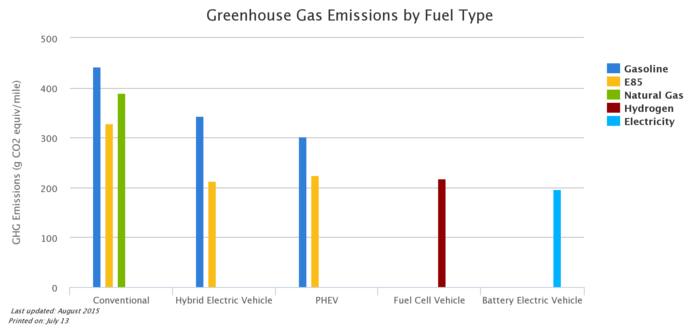GHGs for AFVs
Alternative fuel vehicles or AFVs produce considerably less greenhouse gas emissions or GHGs compared to gasoline vehicles. Currently, around 95 % of energy used by vehicles is derived from crude oil. On a lifecycle basis, natural gas reduces greenhouse gas emissions by an estimated 20-25% compared to conventional (gasoline or diesel) vehicles.[1] To get a realistic value for emission, a life cycle analysis has to be performed. This analysis includes the manufacture of each AFV, transportation of fuel, and infrastructure needed, in addition to the emissions from operating the vehicle.
In 2010, Canada’s transportation sector contributed to the largest greenhouse emissions by economic sector, 24%.[1] Growth in greenhouse emissions from the transportation sector is usually from medium/heavy duty vehicles, and pickup trucks or sport utility vehicles.
As you can see in figure 1, emission from AFVs vary dramatically by type (although all are less than the 450 gCO2e/mile for gasoline).[2]Compressed natural gas produces slightly more carbon dioxide than hydrogen from natural gas, but electric vehicles are the clear winner on this scale. One must also compare price of energy and the convenience of the alternative fuel vehicle infrastructure.

For Further Reading
- Alternative fuel vehicle
- Greenhouse gas emission
- Gasoline
- Natural gas
- Electric vehicle
- Or explore a random page
References
- ↑ 1.0 1.1 Natural Gas Use in the Canadian Transportation Sector, “Deployment Roadmap,” 2010. [Online]. Available: http://oee.nrcan.gc.ca/transportation/alternative-fuels/resources/2888 [Accessed on 20 October 2013].
- ↑ 2.0 2.1 Alternative Fuels Data Center: Maps and Data - Greenhouse Gas Emissions by Fuel Type", Afdc.energy.gov, 2018. [Online]. Available: https://www.afdc.energy.gov/data/10741. [Accessed: 13- Jul- 2018].

